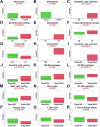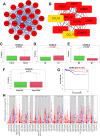The role of immune cells and immune related genes in the tumor microenvironment of papillary thyroid cancer and their significance for immunotherapy
- PMID: 39103463
- PMCID: PMC11300445
- DOI: 10.1038/s41598-024-69187-9
The role of immune cells and immune related genes in the tumor microenvironment of papillary thyroid cancer and their significance for immunotherapy
Abstract
Papillary thyroid carcinoma (PTC) is the most common pathological type of thyroid cancer (THCA) and shows a better prognosis than other types. However, further research is needed to determine the risk of PTC. We herein used the CIBERSORT algorithm to analyze the gene-expression profile obtained from TCGA, estimated the infiltration ratio of 22 immune cell types in tumor tissues and normal tissues, analyzed the differential expression of immune-related genes, and identified immune cells and immune-related genes related to clinical progress and prognosis. We uncovered 12 immune cell types and nine immune-related genes that were closely correlated with TNM staging, and two immune cell types (activated NK cells and γδT cells) and one immune-related gene (CD40LG) that were associated with prognosis. After evaluation, four immune cell types could be used to determine low-risk PTC, with six immune cell types and six immune-related genes closely associated with high-risk PTC. The type and quantity of infiltrating immune cells in the microenvironment of PTC, as well as immune-related genes, appear to be closely related to tumor progression and can therefore be used as important indicators for the evaluation of patient prognosis. We posit that the study of immune cells and immune-related genes in the tumor microenvironment will facilitate the determination of low-risk PTC more accurately, and that this will greatly promote the development of high-risk PTC immunotherapy.
Keywords: CD40LG; Immune genes; PTC; Tumor microenvironment.
© 2024. The Author(s).
Conflict of interest statement
The authors declare no competing interests.
Figures






References
MeSH terms
Substances
Grants and funding
LinkOut - more resources
Full Text Sources
Medical

